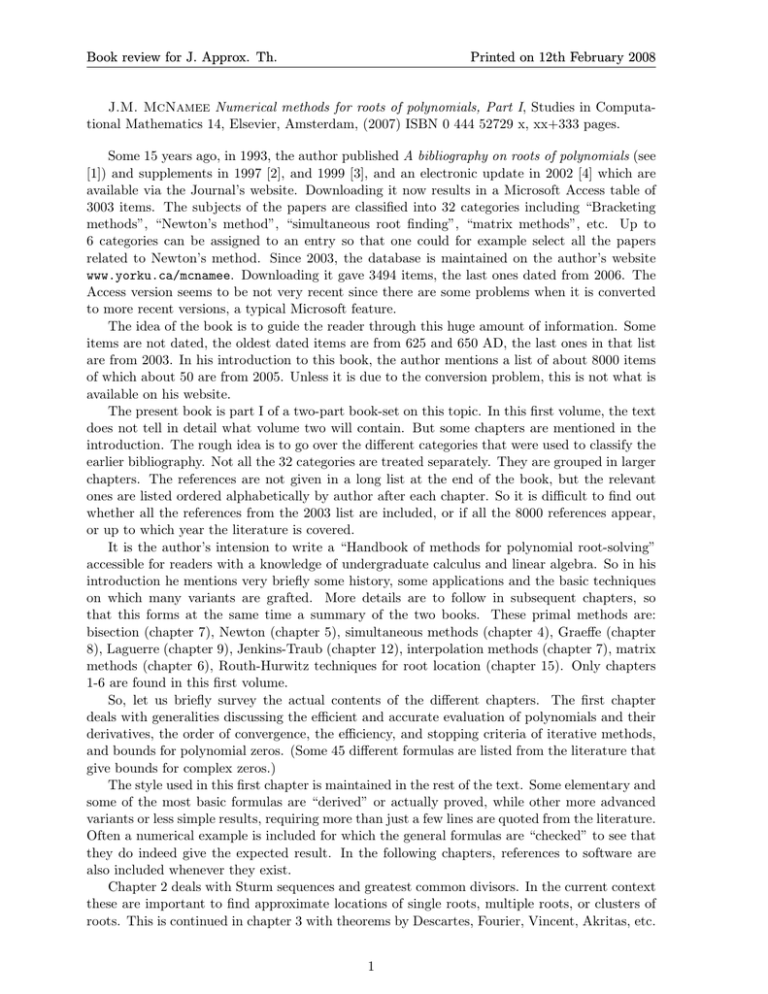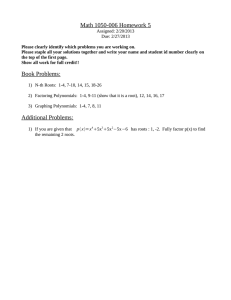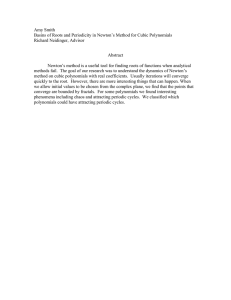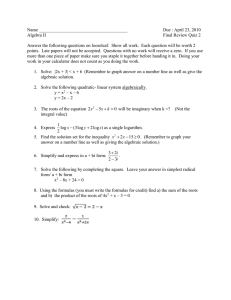Book review for J. Approx. Th. Printed on 12th February 2008 Book
advertisement

Book review for J. Approx. Th. Printed on 12th February 2008 J.M. McNamee Numerical methods for roots of polynomials, Part I, Studies in Computational Mathematics 14, Elsevier, Amsterdam, (2007) ISBN 0 444 52729 x, xx+333 pages. Some 15 years ago, in 1993, the author published A bibliography on roots of polynomials (see [1]) and supplements in 1997 [2], and 1999 [3], and an electronic update in 2002 [4] which are available via the Journal’s website. Downloading it now results in a Microsoft Access table of 3003 items. The subjects of the papers are classified into 32 categories including “Bracketing methods”, “Newton’s method”, “simultaneous root finding”, “matrix methods”, etc. Up to 6 categories can be assigned to an entry so that one could for example select all the papers related to Newton’s method. Since 2003, the database is maintained on the author’s website www.yorku.ca/mcnamee. Downloading it gave 3494 items, the last ones dated from 2006. The Access version seems to be not very recent since there are some problems when it is converted to more recent versions, a typical Microsoft feature. The idea of the book is to guide the reader through this huge amount of information. Some items are not dated, the oldest dated items are from 625 and 650 AD, the last ones in that list are from 2003. In his introduction to this book, the author mentions a list of about 8000 items of which about 50 are from 2005. Unless it is due to the conversion problem, this is not what is available on his website. The present book is part I of a two-part book-set on this topic. In this first volume, the text does not tell in detail what volume two will contain. But some chapters are mentioned in the introduction. The rough idea is to go over the different categories that were used to classify the earlier bibliography. Not all the 32 categories are treated separately. They are grouped in larger chapters. The references are not given in a long list at the end of the book, but the relevant ones are listed ordered alphabetically by author after each chapter. So it is difficult to find out whether all the references from the 2003 list are included, or if all the 8000 references appear, or up to which year the literature is covered. It is the author’s intension to write a “Handbook of methods for polynomial root-solving” accessible for readers with a knowledge of undergraduate calculus and linear algebra. So in his introduction he mentions very briefly some history, some applications and the basic techniques on which many variants are grafted. More details are to follow in subsequent chapters, so that this forms at the same time a summary of the two books. These primal methods are: bisection (chapter 7), Newton (chapter 5), simultaneous methods (chapter 4), Graeffe (chapter 8), Laguerre (chapter 9), Jenkins-Traub (chapter 12), interpolation methods (chapter 7), matrix methods (chapter 6), Routh-Hurwitz techniques for root location (chapter 15). Only chapters 1-6 are found in this first volume. So, let us briefly survey the actual contents of the different chapters. The first chapter deals with generalities discussing the efficient and accurate evaluation of polynomials and their derivatives, the order of convergence, the efficiency, and stopping criteria of iterative methods, and bounds for polynomial zeros. (Some 45 different formulas are listed from the literature that give bounds for complex zeros.) The style used in this first chapter is maintained in the rest of the text. Some elementary and some of the most basic formulas are “derived” or actually proved, while other more advanced variants or less simple results, requiring more than just a few lines are quoted from the literature. Often a numerical example is included for which the general formulas are “checked” to see that they do indeed give the expected result. In the following chapters, references to software are also included whenever they exist. Chapter 2 deals with Sturm sequences and greatest common divisors. In the current context these are important to find approximate locations of single roots, multiple roots, or clusters of roots. This is continued in chapter 3 with theorems by Descartes, Fourier, Vincent, Akritas, etc. 1 Book review for J. Approx. Th. Printed on 12th February 2008 and continued fraction methods to find the number of real zeros in a certain interval. Nothing really new has happened about these topics in the last decades. That is somewhat different for the methods of chapter 4. These methods may compute several roots simultaneously, or clusters of roots of multiple roots. Although having older origins, they have been reactivated since the 1960’s. Not only methods suitable for parallel implementation, but other techniques involving higher order derivatives, square roots, interval arithmetic, Gauss-Seidel and SOR techniques, or hybrid methods are covered. Their convergence, accuracy, efficiency, and implementation, are discussed. The same topics return in chapter 5 collecting methods that are in one way or another related to Newton’s method, the archetype of all iteration formulas. The longest chapter, reflecting the currently stil active field of research, is the collection of methods surveyed in chapter 6. The methods of this chapter are based on matrix techniques, the simplest being the computation of the eigenvalues of the companion matrix. But many recent fast and superfast variants are described as well. This book is an extensive guide through the jungle of many methods for a very old problem. The diversity of theoretical, numerical, computational, and complexity aspects, and the wide range of approaches makes the field quite difficult to survey in a well structured way. Where does a particular method belong? To give an example, I was a bit disappointed not to find a description of Bairstow’s method, which I consider to be a classic in this context. I would expect in to be in chapter 5 because of its close connection with Newton’s method. It is indeed mentioned there several times, but I could not find an explicit description. It may be in part 2 though, but I couldn’t spot a cross-reference to where the details are to be found. That makes me wonder more generally what the actual strategy is behind the grouping of references in the chapters as they are now. For most of them it is a logical decision, but it is less obvious for others. So a good index is necessary (which for the moment is only referring to part 1). An hypertext version or a searchable index might even be better. That would include an index of authors, which is now lacking. So, a well elaborated wikipedia-like database with short descriptions of the methods, indexing of the papers, searchable and linked in all possible ways would be a valuable alternative. One last remark. Being a bit of a LATEX purist myself, I was a somewhat frustrated by the sloppy typesetting. Phrases like “. . . replace x by -x in p(x) and. . . ” or “zj = exp(icos−1 xj )”, which can be found throughout the book, or not having the proper punctuation after displayed formulas, and similar typesetting sins gives me the creeps. But this remark does not change the fact that this book (and probably its sequel) in guiding you through a gigantic list of references that has been collected over many years: a sheer drudgery. It is indeed accessible for undergraduates, but it is probably more appreciated by a skilled researchers who wants to look up some idea or reference on a well focused item. References [1] J.M. McNamee. A bibliography on roots of polynomials. J. Comput. Appl. Math., 47:391– 394, 1993. [2] J.M. McNamee. A supplementary bibliography on roots of polynomials. J. Comput. Appl. Math., 78:1, 1997. [3] J.M. McNamee. An updated supplementary bibliography on roots of polynomials. J. Comput. Appl. Math., 110:305–306, 1999. 2 Book review for J. Approx. Th. Printed on 12th February 2008 [4] J.M. McNamee. A 2002 update of the supplementary bibliography on roots of polynomials. J. Comput. Appl. Math., 142:433–434, 2002. Adhemar Bultheel 3




